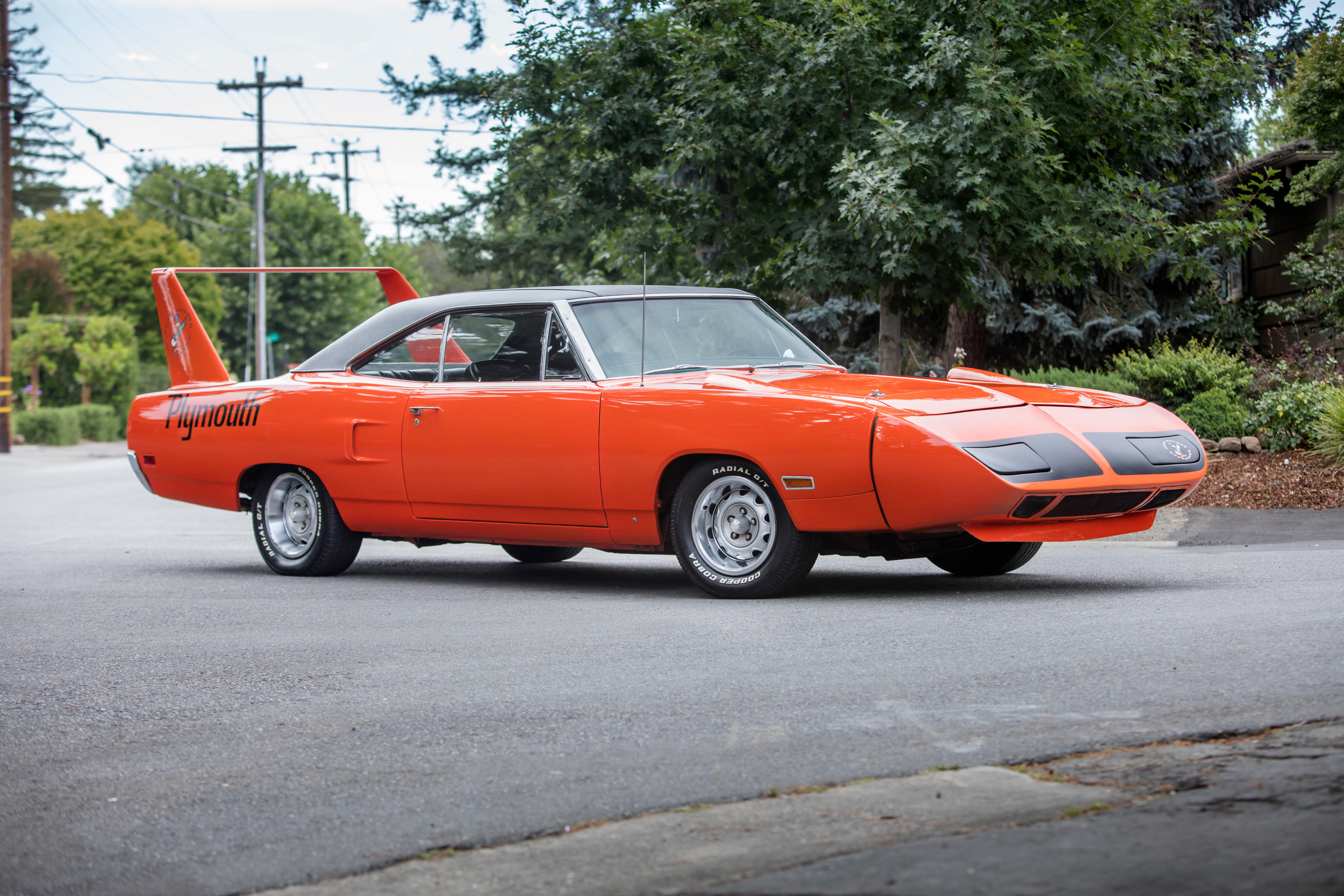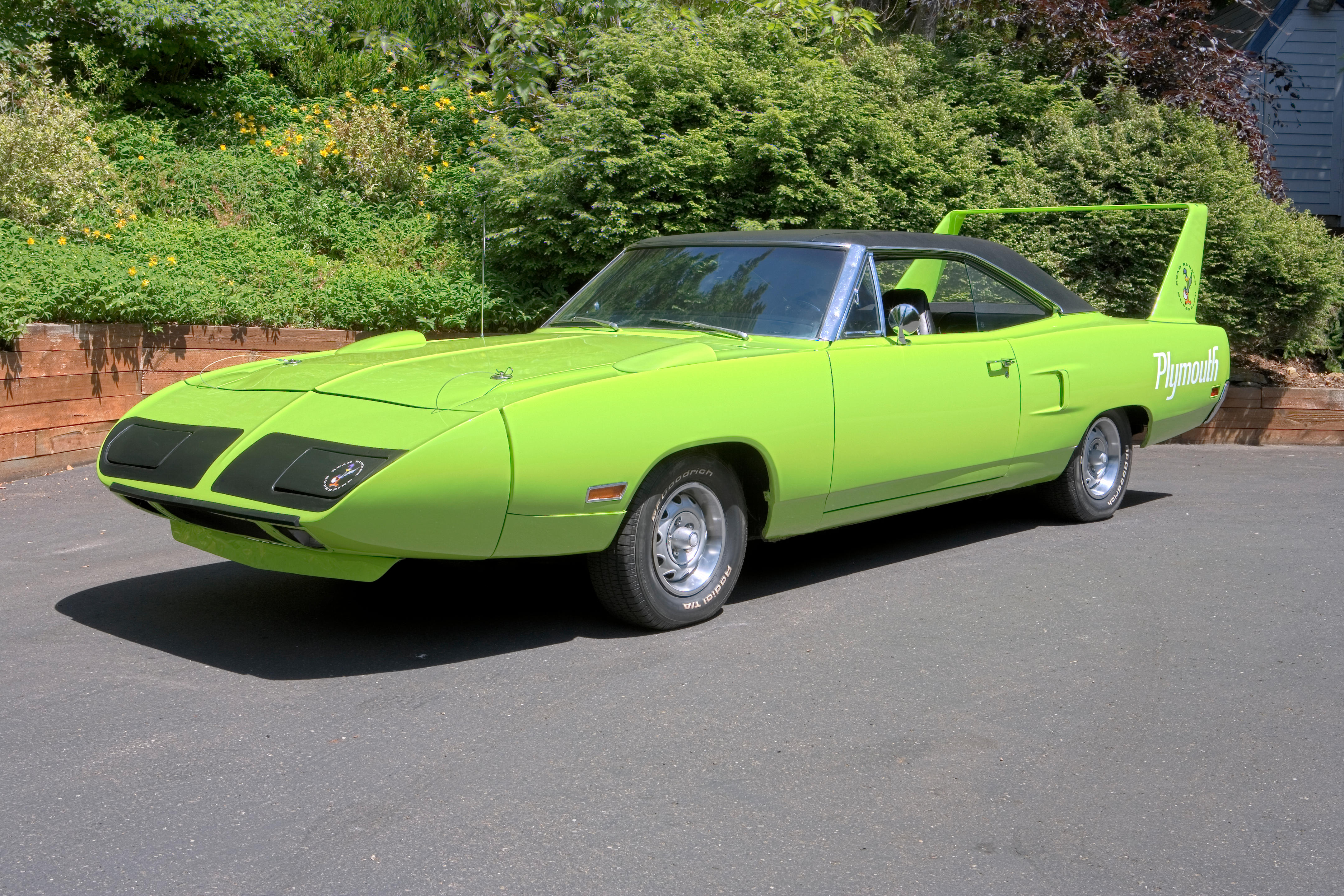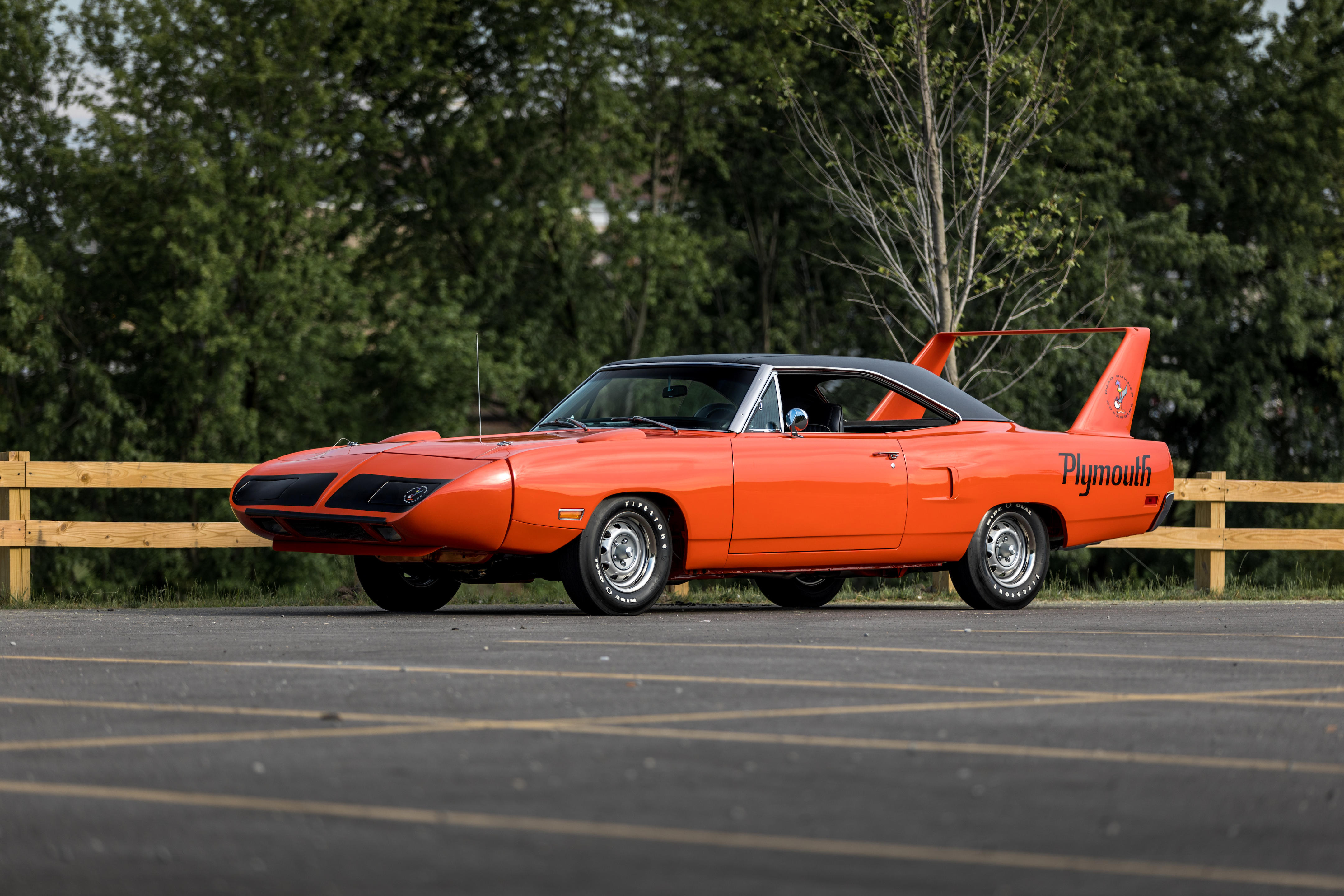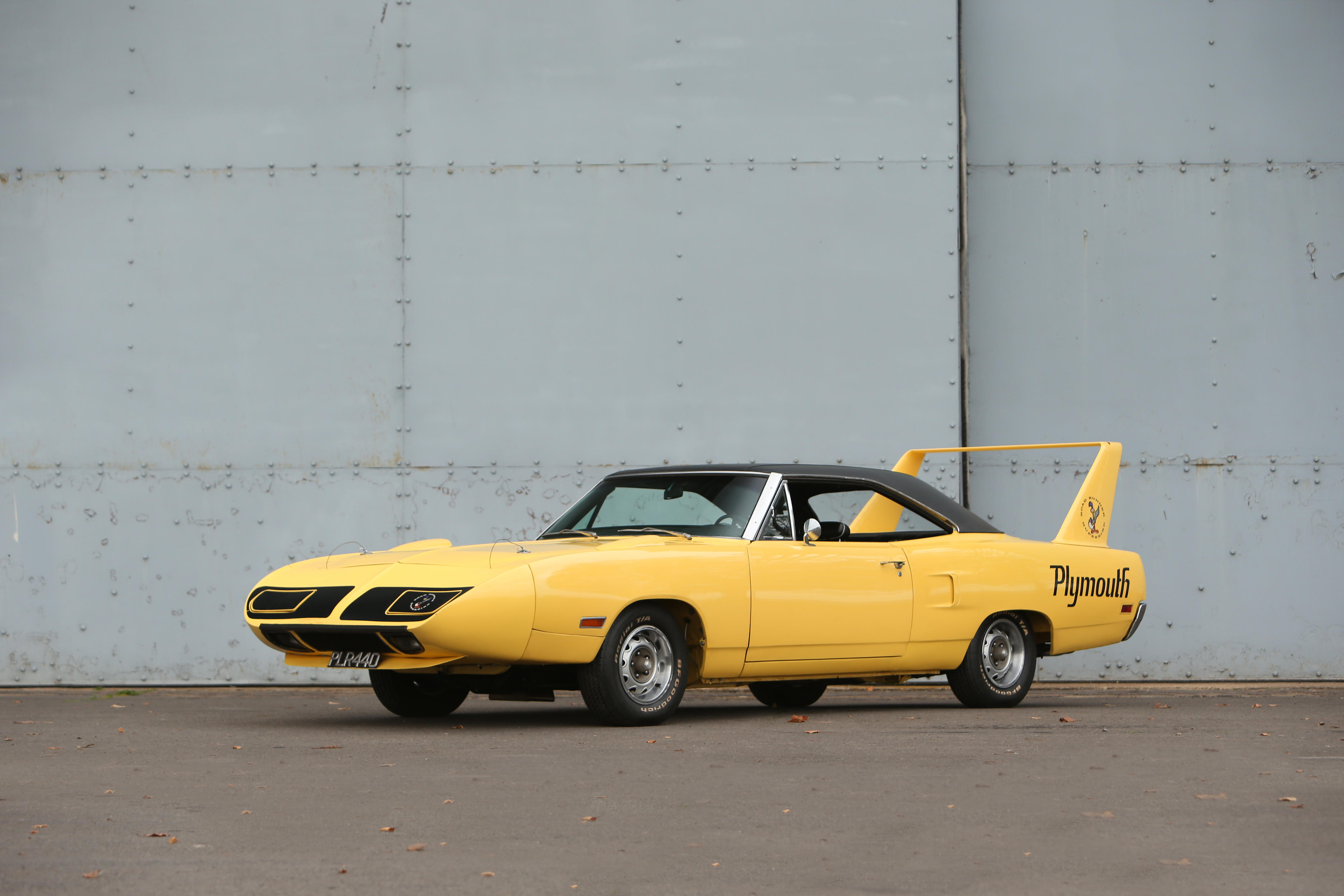440ci OHV V8 "Super Commando" Engine Triple 2-Barrel Downdraft Carburetors 390bhp at 4,700rpm 4-Speed manual transmission Independent Torsion bar front and Semi-Elliptic Leaf Spring Rear Suspension Front Disc and Rear Self-Adjusting Drum Brakes *Just over 21,000 original miles *440 Six Pack with a 4-speed pistol grip *Vibrant Lemon Twist exterior *Numbers Matching engine and transmission THE PLYMOUTH SUPERBIRD The winged Mopars appeared first in 1969 with the Dodge Charger Daytona, carrying streamlining and aerodynamic downforce to new heights in NASCAR. The 1969 regulations required that Dodge build only 500 of the pointy-nose high-wing Daytonas. When Plymouth decided to emulate the success of the Daytona with the Road Runner Superbird in 1970 NASCAR made it quite a bit more difficult, requiring that any model raced in NASCAR be built in sufficient quantity to supply all the manufacturer's U.S. dealers. For Plymouth that meant building nearly 2,000 of its bullet-shaped NASCAR Superbirds, just to qualify them for racing on NASCAR's two high speed ovals, Daytona and Talladega. The concept was defined and the benefits were clear: "Win on Sunday, sell on Monday." A competitive Plymouth also would bring Petty Enterprises back to the Plymouth family. As a racer Richard wanted a competitive car to drive. As a businessman he wanted the Plymouth competition parts distribution franchise. He got both. Then Pete Hamilton, driving a Petty Enterprises Plymouth Road Runner Superbird, won the season-opening Daytona 500. Even though the Dodge Charger and Plymouth Road Runner were built on the same mid-sized Chrysler platform the bodywork was substantially different. Plymouth was forced to develop its own variation on the extended nose, raised wing Charger concept. The Superbird's nose was 1" longer than the Charger's and had a raised entry angle. The rear wing stood on supports with much deeper chord which swept back farther and inclined gently toward the body's centerline. Perfectionists sometimes ask what kind of aerodynamic research the designers at Plymouth did to arrive at the ideal placement height for the rear wing. The answer is somewhat simpler: they didn't do any. It is high enough to allow the trunk lid to open without interference with the wing. NASCAR teams, on the other hand, experimented with chin spoiler placement and wing angle of attack to achieve delicately balanced aerodynamic performance in the different track settings and speeds. The Road Runner Superbird became the most popular and well known of all the NASCAR specials built during the Sixties and Seventies, helped in no small measure by NASCAR's insistence that Plymouth build plenty of them so they created a high profile on the street. Most of the street Superbirds are very well equipped with luxury and convenience options in addition to the performance equipment which was included in the Superbird package. Those included the 375hp 440 Magnum V8, Torqueflite automatic transmission, performance axle, power steering, power disc brakes and hood hold down pins. A black vinyl covered roof also was standard. THE MOTORCAR OFFERED On offer is a wonderful Lemon Twist Yellow Superbird with a matching numbers engine and transmission certified by Galen Govier. This inspection will come documented with the car. With just over 21,000 miles on the odometer it should come as no surprise that this is a very original and well cared for Bird. Well optioned, the engine bay holds the venerable 440ci V8 fed by the top spec 6-pack carburetor set up. The motor feeds into an enthusiasts dream, a 4-speed manual transmission and Sure-Grip heavy duty 9-3/4 Dana 80 differential. Inside, the enthusiast specification continues with bucket seats. Cementing the end of an era with Nascar, the Superbird represents a time of manufacturer and dedication to the series when wild ideas were allowed to fly and be sold in the showroom. Do not miss this wonderful opportunity to get behind the wheel of this glor
440ci OHV V8 "Super Commando" Engine Triple 2-Barrel Downdraft Carburetors 390bhp at 4,700rpm 4-Speed manual transmission Independent Torsion bar front and Semi-Elliptic Leaf Spring Rear Suspension Front Disc and Rear Self-Adjusting Drum Brakes *Just over 21,000 original miles *440 Six Pack with a 4-speed pistol grip *Vibrant Lemon Twist exterior *Numbers Matching engine and transmission THE PLYMOUTH SUPERBIRD The winged Mopars appeared first in 1969 with the Dodge Charger Daytona, carrying streamlining and aerodynamic downforce to new heights in NASCAR. The 1969 regulations required that Dodge build only 500 of the pointy-nose high-wing Daytonas. When Plymouth decided to emulate the success of the Daytona with the Road Runner Superbird in 1970 NASCAR made it quite a bit more difficult, requiring that any model raced in NASCAR be built in sufficient quantity to supply all the manufacturer's U.S. dealers. For Plymouth that meant building nearly 2,000 of its bullet-shaped NASCAR Superbirds, just to qualify them for racing on NASCAR's two high speed ovals, Daytona and Talladega. The concept was defined and the benefits were clear: "Win on Sunday, sell on Monday." A competitive Plymouth also would bring Petty Enterprises back to the Plymouth family. As a racer Richard wanted a competitive car to drive. As a businessman he wanted the Plymouth competition parts distribution franchise. He got both. Then Pete Hamilton, driving a Petty Enterprises Plymouth Road Runner Superbird, won the season-opening Daytona 500. Even though the Dodge Charger and Plymouth Road Runner were built on the same mid-sized Chrysler platform the bodywork was substantially different. Plymouth was forced to develop its own variation on the extended nose, raised wing Charger concept. The Superbird's nose was 1" longer than the Charger's and had a raised entry angle. The rear wing stood on supports with much deeper chord which swept back farther and inclined gently toward the body's centerline. Perfectionists sometimes ask what kind of aerodynamic research the designers at Plymouth did to arrive at the ideal placement height for the rear wing. The answer is somewhat simpler: they didn't do any. It is high enough to allow the trunk lid to open without interference with the wing. NASCAR teams, on the other hand, experimented with chin spoiler placement and wing angle of attack to achieve delicately balanced aerodynamic performance in the different track settings and speeds. The Road Runner Superbird became the most popular and well known of all the NASCAR specials built during the Sixties and Seventies, helped in no small measure by NASCAR's insistence that Plymouth build plenty of them so they created a high profile on the street. Most of the street Superbirds are very well equipped with luxury and convenience options in addition to the performance equipment which was included in the Superbird package. Those included the 375hp 440 Magnum V8, Torqueflite automatic transmission, performance axle, power steering, power disc brakes and hood hold down pins. A black vinyl covered roof also was standard. THE MOTORCAR OFFERED On offer is a wonderful Lemon Twist Yellow Superbird with a matching numbers engine and transmission certified by Galen Govier. This inspection will come documented with the car. With just over 21,000 miles on the odometer it should come as no surprise that this is a very original and well cared for Bird. Well optioned, the engine bay holds the venerable 440ci V8 fed by the top spec 6-pack carburetor set up. The motor feeds into an enthusiasts dream, a 4-speed manual transmission and Sure-Grip heavy duty 9-3/4 Dana 80 differential. Inside, the enthusiast specification continues with bucket seats. Cementing the end of an era with Nascar, the Superbird represents a time of manufacturer and dedication to the series when wild ideas were allowed to fly and be sold in the showroom. Do not miss this wonderful opportunity to get behind the wheel of this glor













Testen Sie LotSearch und seine Premium-Features 7 Tage - ohne Kosten!
Lassen Sie sich automatisch über neue Objekte in kommenden Auktionen benachrichtigen.
Suchauftrag anlegen